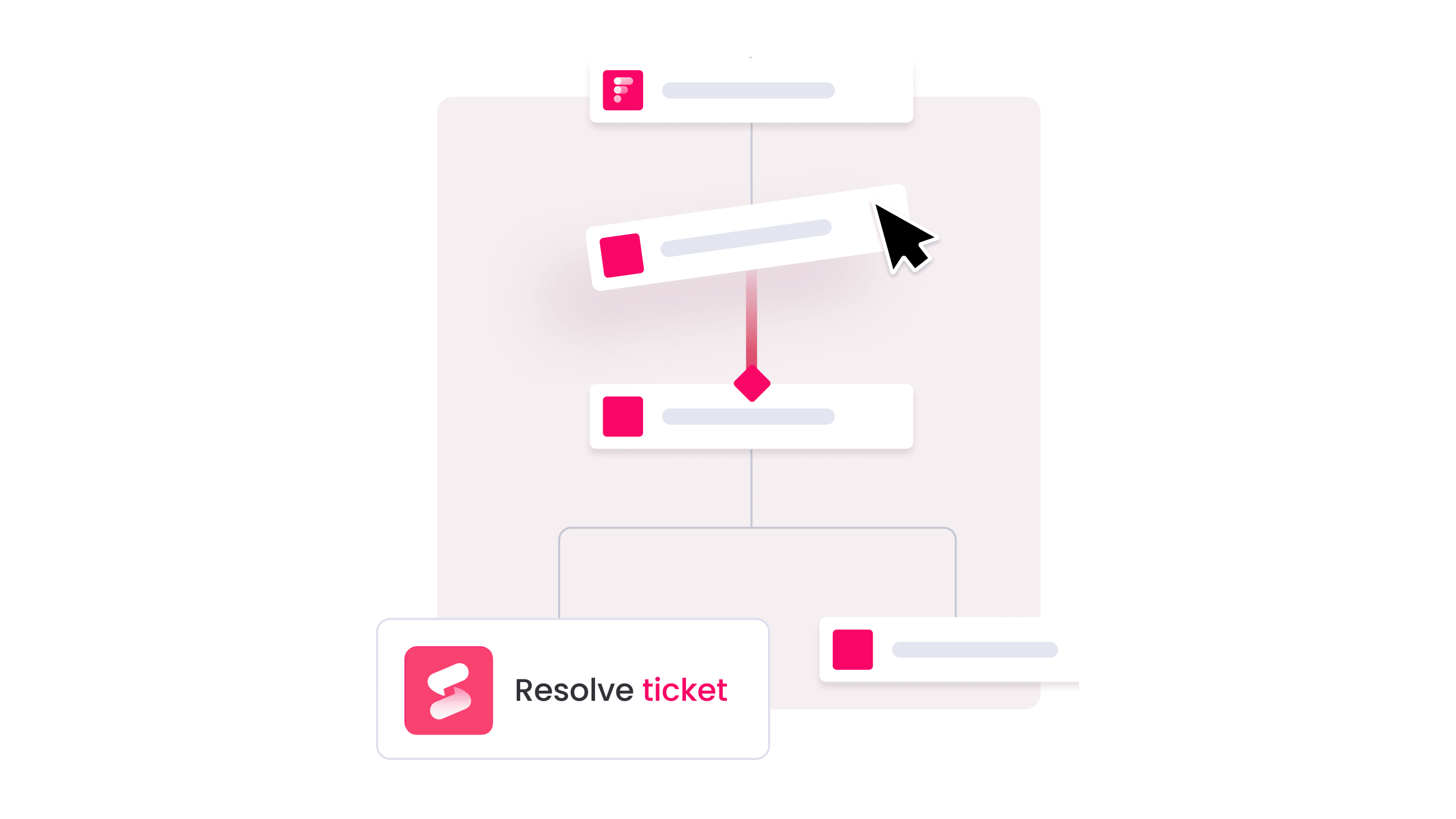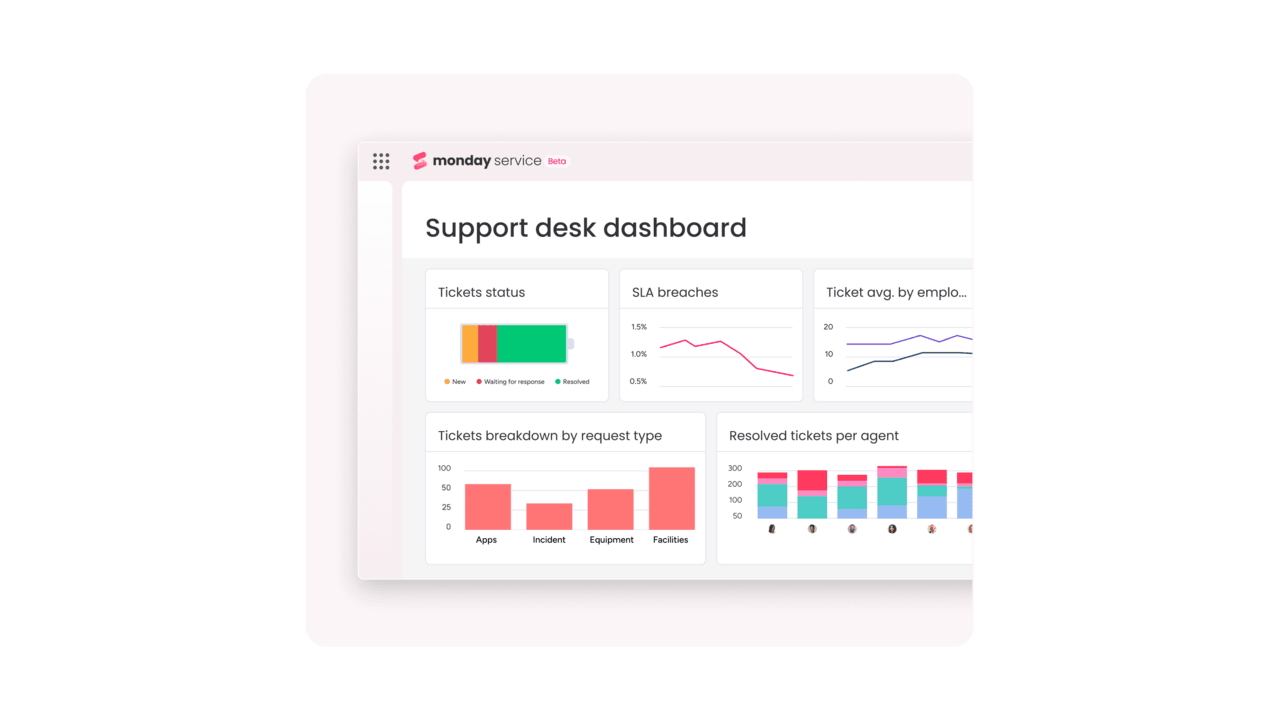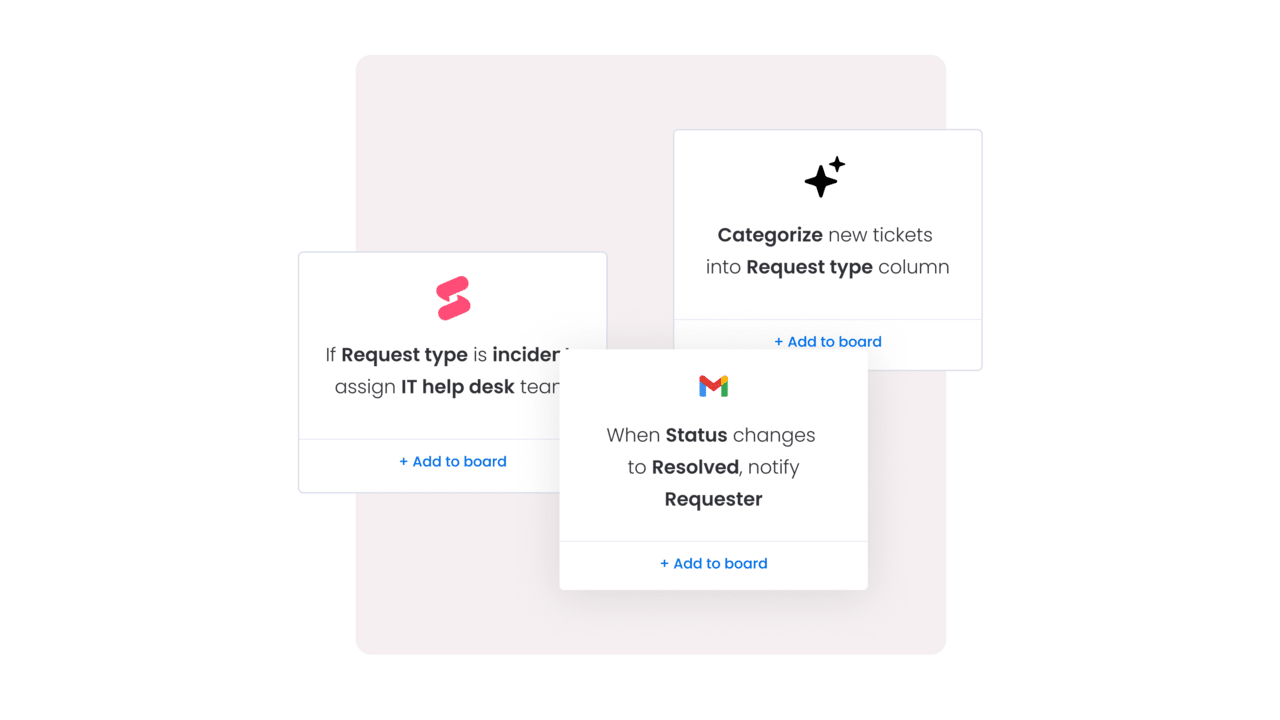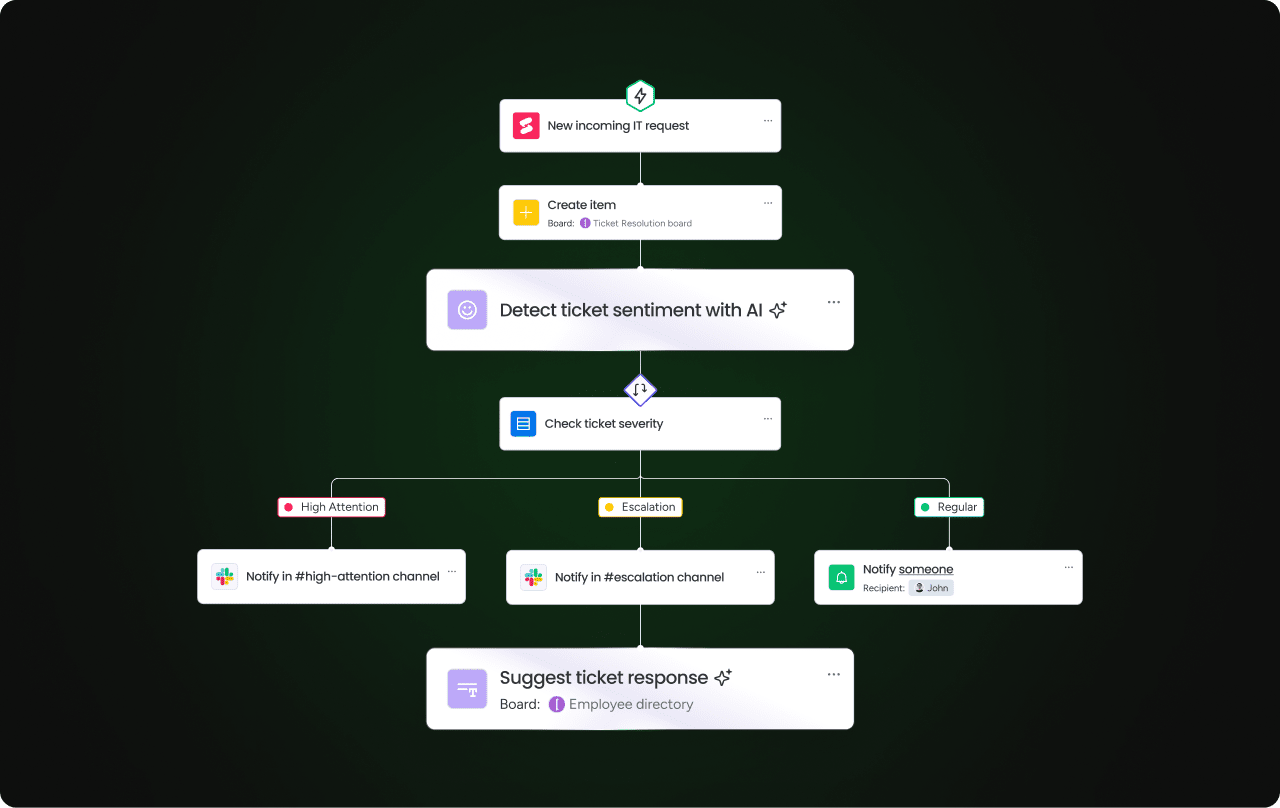In 2013, US retailer Walmart lost an estimated $3 billion in sales due to out-of-stock merchandise. The company blamed poor weather, tax pressures, and a struggling customer base for the loss, but the real issue ran deeper. Inventory was growing faster than sales, yet shelves continued to be empty for customers.
Problems with inventory management are achingly common for businesses. When internal ops teams can’t see what stock is available, where it is, or when it needs to move, this naturally impacts the customer experience and the bottom line. The solution? Artificial intelligence.
This guide explores how AI in inventory management works, along with its benefits and use cases. We’ll also introduce how platforms like monday service support faster, leaner inventory workflows across your operations.
Try monday serviceWhat is AI in inventory management?
AI in inventory management uses artificial intelligence technologies so businesses can better track and manage their stock levels. Instead of setting static reorder points or relying on manual checks, AI inventory systems continuously learn from past sales and supplier behavior to make real-time adjustments and deliver valuable insights.
AI-powered platforms flag inventory issues early, recommend when to restock, and help operations teams act before shortages disrupt the flow of work. The overarching goal is to manage inventory without the usual guesswork.
How to use AI for inventory management
Stock control has always been about balance, but AI brings more focus. Instead of reacting to shortages, teams can fine-tune what they stock and why. As Nidhi Chauhan of Digital Romans puts it:
Smarter stock management isn’t about holding more. It’s about knowing what actually moves the needle.
That’s exactly where AI makes a difference, supporting clearer decisions across every stage of inventory planning. Here’s what you can expect by incorporating AI into your inventory service management strategy.
- Predictive demand forecasting: Analyzing past sales and market signals to estimate demand. These insights reduce the pressure to make gut decisions, especially when conditions change quickly.
- Automated replenishment: Triggering restocks when inventory falls below a set threshold. AI can either suggest the action or handle it automatically, depending on how it’s configured.
- AI-driven categorization and tagging: Grouping products based on how they perform to keep inventory organized and aligned with current demand.
- Inventory segmentation: Applying different strategies to different product types, such as fast-movers, seasonal goods, or essentials. AI clarifies these distinctions without adding manual steps.
- Anomaly detection: Flagging unusual patterns like missing stock, sudden surges, or unexplained slowdowns so teams take action before small issues become big ones.
- Scenario simulation: Testing what might happen under different conditions, such as a delayed shipment or spike in demand.
How you can benefit from AI inventory management
Traditional inventory management often involves working with incomplete or delayed information. AI closes those gaps and delivers the following specific benefits:
Higher inventory accuracy
Inventory is at the heart of every supply-driven business. So, when the numbers are off, everything suffers — products are oversold, stock is misplaced, and customers end up disappointed. These problems are common, which is unsurprising when 58% of retailers and direct-to-consumer brands operate inventories with less than 80% accuracy. AI tightens things up by flagging discrepancies early, syncing data across systems, and cutting back on manual, error-prone work.
Real-time inventory updates boost customer experiences
When inventory data lags behind reality, it creates friction both internally and at checkout. The most common delay between an inventory change and a system update falls between 31 and 59 minutes; only 7% of businesses manage to update their inventory within 5 minutes. That gap has real consequences: 38.6% of retailers cancel at least 1 in 10 customer orders due to stock inaccuracies.
AI solves the problem by keeping systems updated in real time to confirm what customers see is actually available.
Reduced costs through smart inventory holding
Holding too much inventory ties up cash and storage space. Holding too little risks missed sales, and rushed replenishment. So, what’s the right balance? AI finds the perfect middle ground by adjusting stock levels based on actual, current demand. You can expect fewer emergency orders, lower carrying costs, and better use of working capital.
Enhanced scalability
As your operations grow, so does the complexity of managing inventory across different channels and locations. AI supports growth by handling more variables without adding more manual work. Whether scaling to new markets or expanding your catalog, AI maintains system stability while the business moves forward.
Efficient resource allocation
Inventory management depends on coordination across teams, tools, and timelines. AI gives managers clearer insight into what’s needed, so you can focus people and resources where they’ll have the most impact. Instead of reacting to bottlenecks, teams can plan around them.

What are the challenges of using AI in inventory management?
Like any meaningful shift in operations, adopting AI for inventory management comes with a few hurdles. But most of these are practical rather than permanent. Here are some common sticking points you can address early on.
Initial investment
Getting started with AI can seem like a heavy lift. There’s often a perception that it requires a full tech overhaul or a long, complex rollout. In reality, the investment is more about clarity than cost — choosing the right tool, setting clear goals, and making sure the data is ready. When those pieces are in place, adoption moves faster, and the return tends to show up quickly.
Potential data security concerns
AI systems rely on access to large volumes of operational data, which makes security and integrity top-of-mind for any enterprise. When inventory platforms connect across departments, vendors, and regions, the stakes are higher, especially when customer information, supplier terms, or pricing data is involved.
According to the monday.com world of work report, 52% of larger organizations still don’t fully trust the safety and security of AI systems. Even among smaller businesses, 23% cite data integrity or security risks as a reason they haven’t yet adopted AI. The concern is valid, but it’s not a dead end. With the right governance, access controls, and vendor transparency, it’s possible to deploy AI without compromising the trust or compliance standards enterprises depend on.
Fragmented data quality and integration issues
AI tools need consistent, well-structured data to work properly. But in many organizations, inventory data is spread across systems that simply weren’t built to talk to each other.
Fixing these incomplete records and mismatched formats often starts with small steps: aligning data sources, cleaning up inputs, and connecting systems through APIs or middleware. Once the flow is reliable, AI becomes much easier to scale and trust.
Common skill gaps
Even as AI adoption accelerates, many teams still lack the confidence or training to use it effectively. The monday.com world of work report reveals that adoption sits at 69% in supply chain and logistics, for example, but drops to just 53% in operations — often the teams that would benefit most.
Part of the hesitation comes from uncertainty: 33% of Gen Z workers and nearly a third of millennials and Gen X worry AI could put parts of their jobs at risk. Among enterprise companies, 45% report no AI usage, suggesting skills and mindset are holding things back. Bridging this gap means investing in intuitive tools and training that makes AI feel like a support system, not a threat.
Pervasive resistance to change
Rolling out AI means asking people to rethink how they work. The shift can meet real friction, especially in large organizations where change tends to move slowly. Our world of work report found that while 45% of senior leaders believe change is handled well, only 23% of individual contributors agree.
This disconnect can stall adoption before it starts. Resistance usually isn’t about the technology itself; it’s about unclear expectations and a lack of involvement. Conversely, when change is introduced with transparency, context, and support, teams are far more likely to get on board.
7 real-world applications of AI in inventory management
Inventory challenges look different across industries, but AI is flexible enough to adapt to any use case. Here’s what AI in inventory management looks like in 7 real-world scenarios.
1. Manufacturing
AI helps manufacturers predict when they’ll need fresh materials, flags supply risks early, and adjust purchasing based on production schedules. It’s a key tool for keeping assembly lines moving without piling up excess stock.
2. Retail and e-commerce
In retail, AI supports smarter stocking decisions and keeps inventory aligned with customer demand. It also helps retailers shift products between stores or warehouses before stockouts or overstocking can cause problems.
3. Healthcare
Hospitals and clinics use AI to manage critical inventory like medications, equipment, and PPE. Tracking usage patterns and expiration dates makes it easier to avoid shortages without wasting valuable resources.
4. Automotive and spare parts
AI brings much-needed visibility to automotive inventory by predicting which parts are most likely to be needed and when. This intel reduces downtime and keeps dealerships and service centers from tying up capital in unnecessary inventory.
5. Wholesale and distribution
In distribution centers, AI improves inventory turnover by identifying slow-moving products and optimizing storage layouts. It also enables teams to rebalance their stock between locations based on shifting regional demand.
6. Food and beverage
Perishable goods add extra pressure to inventory management. AI tracks shelf life, predicts spoilage risks, and times replenishment more accurately — all of which result in less waste and more reliable supply chains.
7. Construction
Construction teams use AI to manage materials and heavy equipment across job sites. Forecasting usage needs against project timelines reduces delays and cuts down on the costs of storing unused materials.
5 AI tools for inventory management
Choosing the right AI tool depends on how complex your inventory needs are, how your teams work, and how much flexibility you want as your operations grow. Below are 5 platforms worth considering.
1. monday service
Best for: teams that need flexible, AI-powered workflows across inventory, support, and operations.

monday service supports inventory workflows through customizable boards, AI ticketing, and cross-team collaboration, all in one intuitive platform. Its AI capabilities automate routine tasks like restocking triggers, issue routing, and categorization without the need for custom code.
Key features:
- AI service agent for ticket handling and data suggestions
- Automated workflows for restocking triggers and inventory alerts
- Service analytics for tracking inventory-related trends in real time
- Integrations with Outlook, Slack, Azure DevOps, and more
Pricing: Starts at $26/seat/month
Try monday service2. Oracle NetSuite
Best for: large enterprises needing full ERP integration with inventory control.
NetSuite offers a robust, cloud-based ERP system with built-in inventory management. It uses AI to support demand planning, cycle counting, and supply chain automation.
Key features:
- Multi-location fulfilment
Automated replenishment and stock level tracking
360 dashboard for inventory visibility
Pricing: NetSuite platform license pricing is based on company size and configuration.
3. SAP Integrated Business Planning
Best for: global supply chains and complex logistics operations.
SAP IBP is designed for companies managing inventory across regions and partners. Its AI models support demand sensing, capacity planning, and supply chain responsiveness.
Key features:
- Real-time demand forecasting
- Inventory optimization across global networks
- Scenario modeling and “what-if” analysis
Pricing: SAP IBP Starter edition from $29,784.
4. Zoho Inventory
Best for: small to mid-sized businesses looking for automation on a budget.
Zoho Inventory offers cloud-based inventory and order management with automation built in. While not as advanced in AI as others on this list, it supports smart reordering and real-time tracking.
Key features:
- Low-stock alerts and automatic reorder triggers
- Multi-channel inventory sync
- Integration with Zoho ecosystem and e-commerce platforms
Pricing: Free for very small teams; paid plans start at $29/month.
5. Infor CloudSuite
Best for: manufacturers and distributors with industry-specific needs.
Infor’s CloudSuite uses AI to support inventory visibility and warehouse management in sectors like food, automotive, and aerospace. Its built-in industry templates speed up deployment.
Key features:
- Industry-tailored workflows
- Inventory health dashboards and AI forecasting
- Integration with financials and supply chain tools
Pricing: Custom enterprise pricing is available.
monday service: Smarter inventory management powered by AI
Inventory doesn’t sit still, and neither can the teams managing it. That’s where monday service comes in: a flexible, AI-powered platform that helps operations teams automate inventory workflows like stock requests, approvals, and real-time updates. Built to support complex processes across departments, it keeps fast-moving environments organized and responsive.
Here are the specific benefits monday service brings to AI-powered inventory management.
Auto-route the right tasks to the right people
Inventory issues often require cross-team coordination, but delays usually start when tasks end up with the wrong person or sit unclaimed. monday service uses smart routing to assign tasks based on category, urgency, and context. Whether it’s a replenishment request, vendor inquiry, or internal approval, it goes straight to the right person with no manual sorting needed.

Track inventory performance in real time
Report delays leave teams reacting to problems after they’ve already cost time or money. With real-time analytics, monday service includes live dashboards that operations leaders can use to view stock movement, anomalies, and supply trends as they happen.

Sort faster with AI-powered categorization
As inventory grows, so does the time spent organizing it. monday service reduces that overhead with AI-driven auto-categorization, automatically sorting items based on pre-set logic or learned patterns. Teams can focus on decisions and actions without spending time on labeling, tagging, or re-sorting lists.

Free your team from repetitive inventory tasks
Instead of handling the same low-value inventory requests or status updates repeatedly, teams can rely on the AI service agent to step in. It offers in-context assistance, answers routine questions, and completes tasks faster by drawing on past actions and current data.

Move faster with suggestions that make sense
Inventory teams make dozens of decisions each day. With AI suggestions built into the monday service workflow, those decisions get easier. The platform flags unusual trends, recommends next steps and prioritizes what needs attention without interrupting the flow of work.

Inventory management is at its best when responsive, accurate, and low-friction. AI makes that possible — not by replacing teams, but by tracking stock in real time, preventing issues earlier, and spending less time on manual tasks. monday service brings these capabilities into a single service management platform, built to support the day-to-day realities of operations and logistics teams.
Get a free trial and see how monday service helps you manage inventory with more control and less overhead.
Try monday service
FAQs
How are AI and IOT used in inventory management?
AI and IoT work together to give businesses real-time visibility into their inventory. IoT devices, such as RFID (radio frequency identification) tags and smart sensors, track where items are, how they're moving, and in some cases, the conditions they’re stored in. AI uses this continuous stream of information to forecast demand, trigger reorders, and flag issues like missing stock or changes in temperature.
How does AI improve inventory management in the supply chain?
AI improves inventory management by analyzing demand patterns, predicting supply disruptions, and automating stock decisions. The technology helps supply chain teams reduce lead times, prevent stockouts, and make faster adjustments based on real-time conditions.
How does Amazon use AI for inventory management?
Amazon’s Sequoia system integrates mobile robots, gantry systems, and robotic arms to streamline inventory storage and retrieval, enabling the company to identify and store inventory up to 75% faster and reduce order processing time by up to 25%. Additionally, Amazon uses robotic arms like Sparrow to handle repetitive tasks, improving efficiency and employee safety.
Can inventory management be automated?
Yes, it’s possible to automate many aspects of inventory management using AI, sensors, and connected software. Businesses can automatically track stock levels, trigger reorders, and forecast demand without manual input.
 Get started
Get started 
